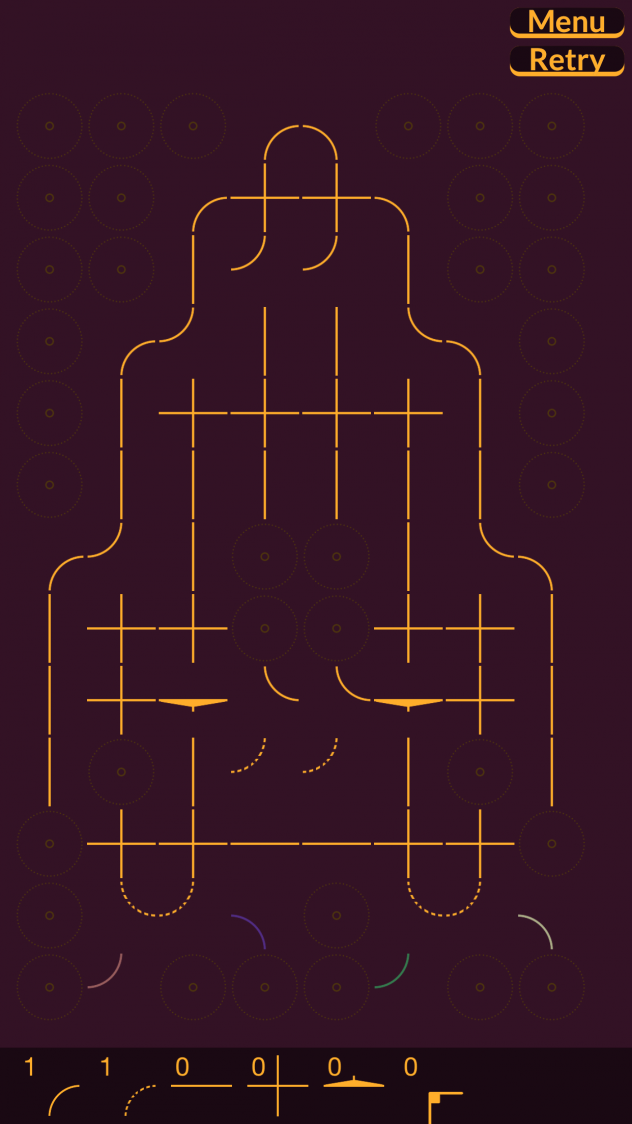In the last episode we have established the very basic concept of this game. Yet we do not have a game yet. We discovered the fundamental mechanic which we have to still develop a fun to play game around. The mechanic itself is already satisfying: I had a very, very unproductive day lying in my bed enjoying just the wobbling reactions by themselves. It was relaxing and I simply couldn't stop. I knew I was on a good path…
Game Modes
During this "unproductive" day I realised that I had separated arcs on the grid that did not have any neighbour pointing at them. Rendering them “useless” to turn. So I made them collectable by the player. These arcs are isolated and will later enable the player to unlock different color themes and arc shapes.
I loved the pure, meditative and satisfying vibe I felt from just playing around with the basic concept. I desired to offer this mode in the game for people who are as fascinated by this reaction as I am. I also added a counter which will reset every time a new reaction is started. This offers some strategic depth to the player which I will talk about in the future. Every time I scored 42 my game-sense told me, that I should receive an achievement for this. I implemented 26 GameCenter achievements hidden between 10 and 800 on the score scale. Even though my play-count is way above the 10k mark, I still haven't managed to unlock them all. Each of these special numbers is an homage to a mathematical or pop-cultural reference. This creates a well rounded game mode called: Sandbox.
While having a lot of fun in my new virtual sandbox, many of my (non-casual) gamer friends told me that it was not meeting their demands of a "real" game and they were right. I still felt I was just barely scratching the surface of what was possible with it.
I fiddled around with the idea of having multiple targets randomly spread around the grid (randomly, but not at the very border). The player was not trying to achieve the longest reaction anymore, yet a very precise one. You have to track back possible paths and plan your reaction to achieve good scores. To balance out the randomness of the target locations, you have 3 tries and the score will be added up during those. Sometimes it would make sense to waste a move just to establish a new path for the second move that can hit multiple targets at once. The Target Mode was born.
As I started to think about the strategies behind this game, I wanted to learn more about the specific constellations I found on the board. I learned how triplets looked like, how to bounce a rotation back and even how to start counter rotations. Most games put the player in a state of the level were the entropy is high: Many enemies are running around, cards are out of order, random stones falling from the top, coins are lying around or you are altering the landscape to survive a night filled with brain nibbling zombies. You can break down a lot of concepts to the idea of establishing some sort of order in a level.
So I came up with a Solitaire idea, where you are allowed to turn less or equal the amount of arcs you had already turned before in ascending order. Yeah, it's a bit more complicated, but stay with me: First try you have to hit exactly 1 arc. Second try you are allowed to hit 1, but your goal is to hit a reaction of 2 elements. You stay as long on this stage until you hit exactly 2. Then this goal increases to 3. You are working your way up the leaderboard, thinking about how to use small and controlled reactions to pave the way for the big ones. This so called Iteration Mode is very challenging and plays like a Puzzle…
…which leads us to the last and most complex mode in the game: Puzzle. During my long studies I had a few semesters of electronics and am therefore familiar with the concept of circuit plans. I liked the idea of creating a map the user has to complete with different pieces to accomplish a goal. The goal is to hit the blinking targets in one single reaction. I implemented several elements to the game, destructible arcs, AND-elements, crossings, curves and forwarding elements. This introduced a whole bunch of new opportunities: Timing became relevant, because some elements enabled forwarding the reaction immediately. I had a lot of fun experimenting and creating some official maps for this mode. It does also feature an editor where you can create your own maps and share them with your friends mail or your messenger application of choice…
One of the official maps called Faster Than Light

